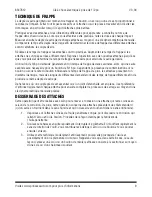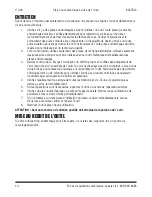
1/2 in. dr Electric Impact Wrench
Visit www.princessauto.com for more information
5
8547812
V 3.04
4. Grounded tools must be plugged into an outlet that is properly installed and grounded in
accordance with all codes and ordinances. Never remove the grounding prong or modify
the plug in any way. Do not use any adapter plugs. Check with a qualified electrician if you
are in doubt as to whether the outlet is properly grounded. If the tool should electronically
malfunction or break down, grounding provides a low resistance path to carry electricity
away from the user.
5. Do not abuse the cord. Never use the cord to carry tools or pull the plug from an outlet.
Keep the cord away from heat, oil, sharp edges or moving parts. Do not operate this tool if
the power cord is frayed or damaged. Replace damaged cords immediately. Damaged cords
increase the risk of electric shock. Do not modify the plug in any way.
6. When operating a power tool outside, use an outdoor extension cord marked “W-A” or
“W”. These cords are rated for outdoor use and reduce the risk of electric shock. Use in
conjunction with a Ground Fault Circuit Interrupter (GFCI). If operating a power tool in a
damp location is unavoidable, the use of a GFCI reduces the risk of electric shock. It is
recommended that the GFCI should have a rated residual current of 30 mA or less.
7. Avoid using an unnecessarily long extension cord. Choose a cord that is appropriate for the
situation, as a cord that is too long and running across the floor can be more dangerous
than helpful. Using a cord that is too long or too thin could damage the tool. Unroll the cord
completely to prevent it from overheating.
8. Place the electrical cord in a position that prevents it from coming into contact with the tool
and from getting caught by the work piece. The cord should always stay behind the tool.
VIBRATION PRECAUTIONS
This tool vibrates during use. Repeated or long-term exposure to vibration may cause temporary or
permanent physical injury, particularly to the hands, arms and shoulders.
1. Anyone using vibrating tools regularly or for an extended period should first be examined by
a doctor and then have regular medical check-ups to ensure medical problems are not being
caused by or worsened from tool use. Pregnant women or people who have impaired blood
circulation to the hands, past hand injuries, nervous system disorders, diabetes or Raynaud’s
Disease should not use this tool. If you feel any medical symptoms related to vibrations
(such as tingling, numbness, and white or blue fingers), seek medical attention as soon
as possible.
2. Do not smoke during use. Nicotine reduces the blood flow to the hands and fingers,
increasing the risk of vibration-related injury.
3. Wear suitable gloves to reduce the vibration effects on the user.
4. Use tools with the lowest amount of vibration when there is a choice between
different processes.
5. Do not use for extended periods. Take frequent breaks when using this tool.
6. Let the tool do the work. Grip the tool as lightly as possible (while still keeping safe control
of it).
7. To reduce vibrations, maintain the tool as explained in this manual. If abnormal vibrations
occur, stop using this tool immediately.

































